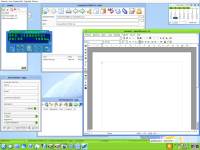Installing Linux with Windows

Installing Windows with Linux is not always without risk. This article describes
the installation of a Linux distribution in general alongside Windows. The
choice of the distribution is left to the user.
The most prominent distros are Suse, Fedora, Debian, Ubuntu (or Kubuntu),
Mandriva, or Knoppix.
Required
The installation CD or an ISO image to burn. It is possible with some distributions
as Suse to install from Windows.
Installing Linux
Choose always the "expert mode" or "advanced", it
is not more technical, and it opens up essential options.
- It is better to use a second disk specially for Linux. Otherwise you can split the Windows partition.
- If you have a partition available and free, ignore this section, go to
3)
- Use SCANDISK (System Tools) to repair any errors on the hard disk.
- Use DEFRAG to prepare partitioning leaving a block of free space.
Take note of the available disk space is you resize the partition from Linux.
Vista makes it possible to resize the partition to create another which can be used for Linux.
You can also choose installation on USB disk. Verify prior that the boot sector of the system can be restored from the Vista disk! - Insert the CD in the drive.
Restart your computer, press DEL or F1 or any key that open the Bios configuration panel, and configure options in the BIOS so that the computer starts with CD-ROM. Save and continue the boot process. You then need to boot from the Linux CD. - You are asked to choose between the expert mode or not. The second will install Lilo Grub or without prompting you. If you install Lilo on the Windows partition, you will have to choose between Windows and Linux at each startup. Choose expert.
- Choose keyboard, language, etc ...
At the option of partition, if you do not have a free disk or a free partition, you have to resize that of Windows. Create a swap partition in this space according to the table below.
It takes at least 2 gigabytes to install Linux. Linux read Windows FAT and NTFS directories, do not try to create a too large partition. - Click on the space for the swap partition, make it SWAP and MOUNT it.
Click on the other Linux partition. Make it Linux and put / for the root directory.
The file system recommended is ext3. - Continue with the graphical install.
You might be asked to install Lilo or Grub, the boot loader, choose Grub. - Continue with the other options.
- To start on the USB disk, reboot your computer and go to the BIOS. Choose the USB reader as the first unit to start (boot).
- Change according your need prompt and environment variables, see below.
|
Size of the swap partition
|
|
|
Memory
|
Swap
|
|
256
|
512
|
|
512
|
1024
|
|
1024
|
1592
|
|
2048
|
2048
|
Packages
To install a rpm package, just click on it from the file manager. Mandriva, Suse, Fedora are using this format.
Knoppix and Debian packages using apt for the applications that you want
to add. To install an apt package, just click on it from the file manager.
To install a tar.gz archive:
- Start as root user, or enter in superuser mode (type su).
- Copy the archive file into /usr/local.
- Type: tar-zxvf archivename
- Enter Into the newly created directory
- According to what is stated in the INSTALL text file, you may have to type commands like: ./configure, make, etc.
- It may be necessary to add the program to the path.
Edit the /etc/profile file, add the path to the executable (not the file name) to the PATH variable, separated by the symbol ":". - Close the session and restart as normal user before using the program.
Editing Bashrc
To change the prompt into something decent to gain access to programs, particularly in the current directory. Here is an example to the directory /home/user, add these lines ...
PATH=/bin:/sbin:/usr/bin:/usr/sbin:/usr/X11R6/bin:/usr/local/bin:.:/home/d:/home/user PS1="\w>" PRINTER=epson/55 export JAVA_HOME=~/jdk1.5 alias cprinter=/usr/local/epson/55/bin/lsc export cprinter
Before buying hardware
Before buying hardware, go beyond the list provided on the site of the Linux distribution. Consult sites like Linux Printing and read all the FAQs and forums.
More d'informations
- Linux Questions. Answers to your questions.
- Comparing filesystems for Linux. Choose the best file system for your needs (But ext3 is recommended).
- Windows software running
under Linux, with Wine.

